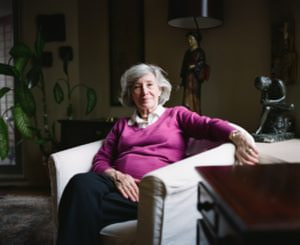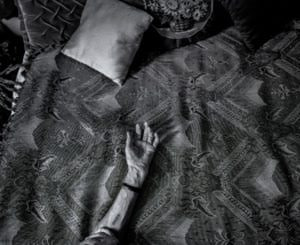A photography exhibition jointly organized with the Robert Capa Contemporary Photography Center in the courtyard of the Holocaust Memorial Center. Open until August 31, 2022, Tuesday–Sunday, 10 a.m.–6 p.m. (admission until 5 p.m.) Entry free.
Curator: István Virágvölgyi
Eight decades on, the Holocaust is increasingly relegated to the pages of history books for younger generations. This is why it is important that the testimony of the survivors was captured at the very last moment by two Hungarian photographers. Robert Laszlo Bacsi spent a decade photographing Holocaust survivors living in Budapest, while Ildi Hermann visited Hungarian Holocaust survivors living in New York to take their portraits and interview them.
Photography is a unique art form, because it does not fill blank paper with content, like painting, but cuts out a slice of the infinite complexity of the world and renders it meaning. The choice of moments is therefore of great importance. For each memory is unique and as such dies with the individual, but collective memory is shaped by the images that are somehow recorded and thus preserved, displayed and transmitted. Contemporary artists, among others, have a responsibility in this!
In addition to the two creative attitudes, the photographs also reveal the imprints of two different life strategies: of those who stayed and of those who moved far away. However, it is not the differences but the similarities that are most striking in these series of photographs. Despite the 7,000 kilometers of distance, one can hardly come to any other conclusion when looking at the photos than that these people are united by something, and that is why it is worth looking together in the eyes of the subjects of these photographs. Because portrait photography satisfies our primordial curiosity, which compels each of us to be part of the life of the other for a moment, just as we are on the escalator of the underground, looking for the gaze of the people we meet.
As the French poet Charles Baudelaire said, “A portrait! What could be simpler and more complex, more obvious and profound?”

Ildi Hermann’s series Missing Stories, created between 2015-2017, consists of portrait photographs and interviews of Hungarian Holocaust survivors living in New York. The work was inspired by a personal motivation, namely the absence of the photographer, as she had failed to ask her grandmother, also a Holocaust survivor, about her story. All of this, with Ildi’s tragically early death, casts an even more peculiar light on the memory of generations that have gone before us. How much can these photographs convey of the Holocaust we lived through? What did these personal stories, evoked from an almost historical perspective, mean to the subjects of the photographs, what did they mean to the creator and what do they mean to the visitor of today? We are looking at the same picture, but we all see different things, because the photograph is both the photographer’s interpretation of the world and the viewer’s impression of it.

From 2004, Robert Laszlo Bácsi regularly met Hungarian Holocaust survivors at events organized by the Centropa Foundation, and found their life stories so moving that in 2010 he began working on a documentary portrait photo series of them. Many of the subjects of his 2010-2020 work, To Know To Survive, are no longer alive, making the basic message of each photograph even more pronounced: “I was here!” As the aesthete Susan Sontag puts it, “To photograph is to become part of the mortality, the vulnerability, the mutability of someone (or something). Every photograph, precisely because it freezes and petrifies the moment, bears witness to the all-consuming implacability of time.” Let these photographs stand as a testimony to the fact that there were those who survived the unsurvivable, and with their help, let us remember those who perished.
As we look at the photographs in the exhibition together, I hope we will all be bathed in the magic of the duality of photography: just because we see these portrait photographs, it doesn’t necessarily make the people in them feel like close friends, but at the same time they feel very real and tangible. After all, each photo accurately depicts its subject, but it cannot provide us with the truth, we have to dig it up for ourselves.
Excerpt from the opening speech of István Virágvölgyi, curator of the exhibition
